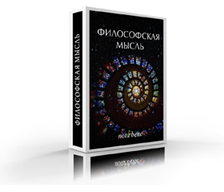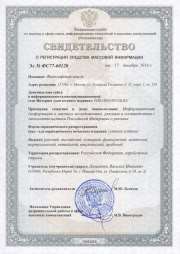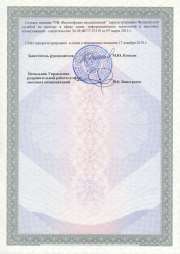|
MAIN PAGE
> Journal "Philosophical Thought"
> Contents of Issue ¹ 11/2023
Contents of Issue ¹ 11/2023
|
Gribkov A.A. - Genesis of equifinality and multifinality of open systems
|
|
pp. 1-9
|
DOI: 10.25136/2409-8728.2023.11.68747
EDN: AFHGHD
Abstract: The subject of research in the article are the properties of equifinality and multifinality of open systems, widely spread in all subject areas, at all levels of organization: in physical, chemical, biological, economic, social, etc. open systems. Equifinality is a dynamic property of a system that realizes movement (transition) in different ways from different initial states to the same final state. Multifinality is the dynamic property of a system to reach fundamentally different final states under insignificant changes in initial conditions. Examples of realization of the properties of equifinality and multifinality in systems of different nature: physical, biological, economic are considered. The genesis of these properties is investigated. On the basis of the study of the genesis of the properties of equifinality and multifinality its commonality is revealed: both properties are a consequence of the transformation of quasi-continuous quantitative changes into discrete qualitative forms, as well as the limited variety of these forms caused by isomorphism. The origin of the multiplicativity property (increased sensitivity to variation of input parameters) and its difference from multifinality are revealed. The multiplicativity property is manifested in systems with unequal stability, including those possessing positive feedback mechanisms. In some systems, such as meteorological mathematical models, the properties of multiplicativity and multifinality appear simultaneously and cannot be unambiguously distinguished.

|
Erendzhenova Y.Y. - Methodological basis for studying the ethical component of the Buddhist creed
|
|
pp. 10-21
|
DOI: 10.25136/2409-8728.2023.11.68947
EDN: NEMWHG
Abstract: The subject of the study is a methodological toolkit for a comprehensive study of ethical ideas contained in the creed of traditional Russian Buddhists — Kalmyks, Buryats, Tuvans, Altaians. The purpose of this study is to substantiate philosophical understanding of the ethical component of the text “Refuge”, recited by traditional Buddhists of Russia. The choice of methodological approaches, principles and methods is determined by the philosophical orientalist paradigm, when Buddhist materials are considered in their integrity, in their inextricable connection with human and culture. Important addition is taking into account ideas of Buddhologist O. O. Rosenberg, who advocated the study of the “living” tradition of Buddhism. The novelty of the study lies in substantiation that a holistic understanding of the ethical component of the Russian Buddhists' creed can be obtained by combining three approaches: philosophy of culture, philosophy of religion, and philosophical anthropology. Philosophical cultural dimension will allow focusing on categories of Buddhist ethics set out in the text “Refuge” and taking into account comments of Buddhist authors in accordance with the principle of “cognitive modesty” of intercultural philosophy. The philosophical religious approach allows to consider the ethical component of the text “Refuge” in a soteriological context and show its place in the Buddhist religious complex. Philosophical anthropology will make it possible to identify the probable subjective meaning of the ethical component of the text “Refuge” for Buddhists. Such a comprehensive philosophical analysis of Russian Buddhists' creed will lead to the discovery of the foundations of their spiritual and moral values.

|
Nesterkin S. - The Philosophy of Schopenhauer in the “Philosophical Notebooks” of B. D. Dandaron
|
|
pp. 22-33
|
DOI: 10.25136/2409-8728.2023.11.69130
EDN: NNFRNT
Abstract: This article presents a previously unpublished manuscript of a lecture on Schopenhauer's philosophy from archival materials of the famous Russian Buddhist scholar and Buddhist teacher B.D. Dandaron (1914–1974). It is part of a series of texts containing notes from lectures and books, his own notes as well as translations that are referred to as his “philosophical notebooks.” They date from 1953-1954, the time when B.D. Dandaron was in a Gulag camp in Taishet (Irkutsk region). This text is part of the materials of a philosophical seminar held by prisoners in their free time from work. The active participants of the seminar were B.D. Dandaron and V.E. Sesemann (1884-1963), a historian of philosophy, follower and colleague of L.P. Karsavin in the Eurasian movement. Sesemann was known for his work in Kantian philosophy and aesthetics. The manuscript argues that Schopenhauer's philosophy represents a unique attempt to combine Kant's epistemology with the ethics and metaphysics of Buddhism. The author notes that an attempt to synthesize such disparate principles should have led to significant intentional reinterpretations of these two very different systems of thought. The content of the work is to determine what new elements Schopenhauer (who considered himself a follower of Kant) introduced into Kant’s philosophy, on the one hand; and the fundamental differences between his philosophy and the teachings of Buddhism, on the other. The text will be of interest both to researchers of V.E. Sesemann (as the probable author or co-author of the work) and B.D. Dandaron. It allows us to understand the philosophical background of the religious and philosophical teaching of neo-Buddhism that they created, which had a great influence on the revival of Buddhism in Russia in the second half of the twentieth century.

|
Ontology: being and nihility |
|
Gaginskii A.M. - Heidegger and Plato's idea of the Good
|
|
pp. 34-64
|
DOI: 10.25136/2409-8728.2023.11.69032
EDN: VKWLWS
Abstract: The article deals with the question of Plato's reception in Heidegger's philosophy. In particular, the research focuses on the question of how Heidegger interpreted the idea of the good from Plato's "State". Here a number of difficulties important for the history of philosophy arise. What is the ontological status of the idea of good? How is the idea of the good connected with the demiurge from the dialogue "Timaeus"? On the one hand, it is well known that the late Heidegger criticized Plato and all European metaphysics, which was and remains Platonism. On the other hand, the early Heidegger clearly presents an attempt to master the shining heights of Platonism: the question of the meaning of being needs an angle from which a definite answer can be highlighted – and Heidegger borrows this angle from Plato. Just as the good endows existence with being and truth, so the understanding of being is possible from time, because it is temporality that is the condition for understanding being, it highlights its meaning. And if Plato's being "pounces" on the good, or on the one, then for Heidegger, time is such a condition. This line of thought, fundamental to the whole project of fundamental ontology, is directly related to the philosophy of Plato, who for the first time was able to rise so high as to become ἐπέκεινα τῆς οὐσίας, to see things as if from the outside, i.e. in the light of the transcendent idea of good. Nevertheless, Heidegger criticizes Plato, which allows us to raise the question: how did Heidegger understand Platonic ἐπέκεινα τῆς οὐσίας and the doctrine of the good? It is impossible to answer this question unequivocally, since Heidegger approached this question from different sides and at different times interpreted this most important position of the Greek thinker in different ways. Nevertheless, the main remarks can be reduced to two: (1) the good was conceived by Plato as something moral and therefore mixed with the existing, (2) the good subordinates the being, brings it under fitness.

|
Komissarov I.I. - External and internal analogies in social and philosophical knowledge in the context of the problem of homogeneity-heterogeneity of societies
|
|
pp. 65-77
|
DOI: 10.25136/2409-8728.2023.11.68810
EDN: VTUHAN
Abstract: The subject of this work is social models that are constructed by using external and internal analogies. External social analogies imply a reference to an object that is studied within the framework of a science being external to social knowledge (physics, chemistry, biology, etc.). In particular, the mechanistic, elementary (chemical) and geological varieties of them are considered. Internal analogies imply a reference to an object that is directly related to the social sciences, social philosophy. Hence, the Baudrillard’s symbolic exchange, McDonaldization and eBayization models are analyzed. Particular attention is paid to the dichotomy of homogeneity-heterogeneity of societies which is revealed within the consideration of corresponding antagonistic social concepts. As a result, after classifying social models from the point of view of external and internal analogies used by creators of these models, the reasons were identified explaining that analogical thinking is so generally accepted and popular in social philosophy. Namely, analogies allow a social model to be more tangible and visual as well as they give it credibility and novelty. In relation to the idea of the homogeneity or heterogeneity of human societies, external and internal analogies allow us to conceptually «color» these abstract notions. The spread of internal analogies presupposes the emancipation of social science from the influence of the idea to build social models in accordance with natural science – the idea that finds vivid expression in models based on external analogies.

|
Gavrish A.D., Gulyaeva E.V., Kompaneeva L.G. - Appeal to the future in mass communication
|
|
pp. 78-89
|
DOI: 10.25136/2409-8728.2023.11.68821
EDN: VZEVNS
Abstract: This article, in the framework of the system approach, considers the category of the future from the perspective of such scientific disciplines as philosophy, discourse linguistics, communication theory, psychology, methodology of science. The authors complete a definitional analysis of concepts related to the human ability to pre-empt the upcoming events (intuition, anticipation, guess, hypothesis, supposition, prediction, forecasting, prophecy). On the material of English-language and Russian-language media texts, the authors show that future can often become a subjective informational base for addressing to the mass audience by public personalities, including politicians. This probably happens due to the patterns of functioning of the human psyche, and due to the fact that there is a constant public request for information appealing to the future time category. Such a request doesn’t often depend on cultural-historical specificity. The authors conclude that prophecy can be understood as a personal particularly significant future and an axiologically super valuable reference point for future discursive connections. Some features of prophecy may include a wide emotional range, which is usually expressed in a compact form, but is potentially unlimited. The axiology of prophecy includes its ability to reduce or modify an area of intact uncertainty. Prophecies largely ensure the existence of emotionally significant non-rejected information, lacking most of the characteristic attributes of a connection with the present or the past. Studying of the deeper philosophical understanding of «prophecy» can become a prospect of further research.

|
Darchinov E.V. - The features of the "electronic nomad" and the risks in his life
|
|
pp. 90-100
|
DOI: 10.25136/2409-8728.2023.11.54681
EDN: WLFXAS
Abstract: The object of the study is a new type of personality that emerged under the influence of digitalization of society – the "electronic nomad". The purpose of the article is to identify its features and problematize the risks arising in the digital world (including on the Internet, social networks, etc.). Research methods – analytical and interdisciplinary approach. As a result of the analysis of the works devoted to the "electronic nomad", the author identified its characteristics. This type of personality is characterized by the ability to function in a multidirectional way in a digital environment through mobile devices and access to the Network, as well as freedom in their movements and manifestations. Subordination to technical devices allows researchers to call an "electronic nomad" a technohuman. In addition to the many advantages that facilitate the life of the "electronic nomad", the digital environment also carries significant risks. These include computer addiction, alienation, manipulation of information, total control, the possibility of leakage of various, including personal, data and information, immorality of relationships in the digital environment, the competitive war of "nomads". The listed negative factors associated with the functioning of the "electronic nomad" in the digital world actualize the problem of creating digital law and paying attention to the moral education of the individual. The conducted analysis initiates further interdisciplinary studies of the "electronic nomad" by specialists from different scientific fields, and the results obtained will help not only to draw up his portrait, but also to predict behavioral algorithms and minimize possible risks.

|
|






